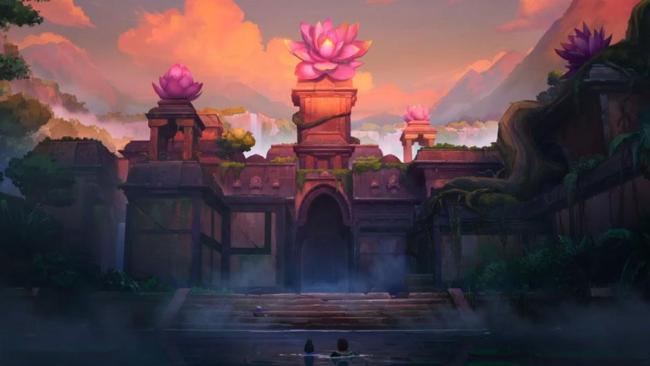The year started pretty well in VALORANT with the arrival of a new map called Lotus. Described as ” a ruin inherited from a distant past », the map is inspired by Indian architecture. In a press release published recently, the developers of the FPS returned to the characteristics of Lotus and took the time to explain to the community where their inspiration came from.
Vegetation at the heart of reflections
When we discover Lotus, the first thing we notice is all this vegetation that composes it. No matter where the gaze lands, it inevitably encounters huge lotus flowers, clusters of lianas or even ferns by the dozens. ” This vegetation develops in disproportionate proportions because it feeds on radianite. The vines serve as conductors to power the ruins, such as the two huge revolving doors near A and C. says George “Riot Dadsquad” Sokol, Environments Art Lead.
According to the developers, the radianite would have helped mutate all the plants on the map so that they could absorb huge amounts of solar energy. Then, the ancient people who once lived there would have used the vegetation to power certain technologies by extracting said energy.
Lotus isn’t just there for gamers to bang on, though. In effect, the map is a key part of the VALORANT story, but very few details have yet been provided on this subject. ” We don’t yet know what exactly this place was used for, but Harbor and the VALORANT protocol feel that Lotus played an important role in the lives of the people who built it. For the moment, we will have to be satisfied with the clues scattered in the structure of the map itself. And watch for narrative elements to appear on the map as the story progresses. »
A card designed for the fluidity of travel
This new map has three sites, each one being connected to the others by long corridors placed in such a way as to make the movements of the players much more fluid. ” We wanted to give teams more flexibility in positioning than they often have on other maps. says Pearl Hogbash.
The particularity of Lotus lies in its two mechanical doors which can be rotated 180 degrees. When opened, they reveal passages previously inaccessible to players. While this may seem appealing at first glance, note however that their opening time is eight seconds, which is relatively long for such a dynamic game.
However, these gates can provide a real strategic advantage if used correctlybecause they allow you to move very quickly from one area to another, but also to block an opposing player who is in one of the passages.

Inspired by real places
Lotus features are inspired by real places and real people of planet Earth. The developers first thought of creating a city straight from antiquity by studying the ruins of Petra, in Jordan. ” And then someone pointed out that we had an Indian agent in development. After some research, we found similar structures in India. It matched perfectly. So that’s where we turned. “says Peppy Yambino. This is how Lotus was born, inspired by the style of the Dravidiansa large ethnic group that lives in India and South Asia.
By carefully studying Lotus, we can indeed see that Dravidian architecture is everywhere, in the rock details, but also in the roofs of the buildings. In addition, the walls are covered with frescoes and engravings that represent elephants, panthers, cobras or even peacocks. Something to amaze players who venture onto the map for the first time.

Lotus is already available on VALORANT so don’t hesitate to start a game to find out if it’s not done yet.
One competition is organized with our partner Instant Gamingwhich allows you to leave with the video game of your choiceof the fifa credits or some V-bucks.
To participate, just click on the following link → Choose my video game !
